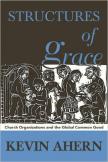Movements Of Faith
Following the Second Vatican Council, there has been a significant growth in the number of lay and ecclesial Christian movements focusing on the building of community, creating peace, fighting for social justice and offering opportunities for prayer and reflection. Following the canon of social teaching developed since Leo XIII’s groundbreaking Rerum Novarum, these organizations have developed to meet the needs of today’s world with a new emphasis on the call for justice mandated in the New Testament. However, the types of movements and the internal struggles that have developed have produced a diverse and unique set of communities that exist for the betterment of mankind.
In Structures of Grace, Kevin Ahern tackles the question of where exactly the balance lies for these organizations between the temporality of social justice and the eternity of the spiritual self. How do organizations strike a fair balance between verticalism (a predominant focus on spiritual needs) and horizontalism (a predominant focus on social justice and earthly needs)? On top of that, Ahern raises the further challenge of organizations that stray away from their initial charism, and from Christianity altogether, and how this may affect their ability to achieve their intended goals. Drawing on his own experience as the former president of International Movement of Christian Students, Ahern provides an insider’s view to the world of Christian lay movements while at the same time producing an overtly scholarly work worthy of our attention. While Structures of Grace is written primarily in the style of a textbook meant for a college seminar, Ahern gives an encompassing picture through the lens of three distinctly different movements: Jesuit Refugee Services, the Young Christian Workers movement, and the Plowshares Movement.
When it comes to organizations that emphasize social justice while remaining within the structures of the Catholic Church, there are few better examples than Jesuit Refugee Services. J.R.S. is an organization that spans the globe, filled with lay and religious volunteers and overseen directly by the Society of Jesus as well as the Vatican. Its highly organized structure, non-governmental organization status, and ecclesial oversight place it very much as an institutional response from the Catholic Church to a continually growing world problem. But that is not to say that it is without its challenges. For example, one of the key components emphasized in J.R.S. is accompaniment, or a direct personal contact with those they seek to help. Yet when J.R.S. makes decisions on actions that advocate on behalf of refugees, there is little to no input from these people. Similarly, one of the greater struggles faced by J.R.S. is how to incorporate non-Christians into their work while maintaining an Ignatian identity central to the work.
Ahern then focuses his narrative on a second type of movement: those rooted in the actions of the laity while remaining close to their Christian identity and, in many cases, the power structures of the church. He highlights the peace-keeping mission of the Community of Sant’ Egidio in Mozambique, the ecumenical community and the prayer life of L’Arche, which brings together people with normal capacities and those with intellectual disabilities, and, finally, the Young Christian Workers, whose efforts—although splintered over the years—continue to empower youth to fight for the rights of the worker.
These communities, organized around structures that are often inclusive of religious influence and have centralized methods of leadership, enjoy a greater sense of freedom within these internal structures. For all the benefits they provide, they, too, are not without their problems. The Y.C.W., for example, is broken into national conferences, and a growing number of these conferences continue to move away from their traditionally Christian identity to become more inclusive as they meet the needs of non-Christian populations. Other groups experience similar problems over mission, either through the rejection or the complete return of their founding charism, the need to be inclusive, or the need to engage a world that is increasingly secular.
A third example that Ahern focuses on is organizations that adhere to a basic mission, but not to a centralized structure. Citing groups including Plowshares and the Catholic Worker Movement, Ahern recognizes that these organizations place a greater emphasis on small community reflection and action. The autonomy placed on these loosely affiliated groups provides benefits in the ability of these communities to respond to the needs of their locales. However, this structure often leads to a greater divergence in what the communities focus on and their methods. The very name of the Plowshares movement, for example, is rooted in Scripture and the foundation of the movement is Christian. However, the movement has become very secularized in Britain and Sweden. Some would argue that this is necessary—to meet the people and their needs.
“Grace,” states Ahern, “is experienced in the world… through the actions of Christians and Christian communities that attempt to bring about positive social transformation aimed at healing broken relationships.” Encapsulating both the essence and the imminent problems faced by social justice movements in Christianity, Ahern provides not only an analytical narrative of what these Christian movements have accomplished, but also inspires the reader to see what they may become. The stories of all Christian movements are intertwined in the sense that, much like the faith from which they draw their inspiration, there is a great uncertainty, only outpaced by a greater hope.
This article also appeared in print, under the headline “Movements Of Faith,” in the February 29, 2016, issue.








